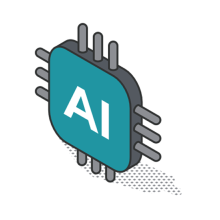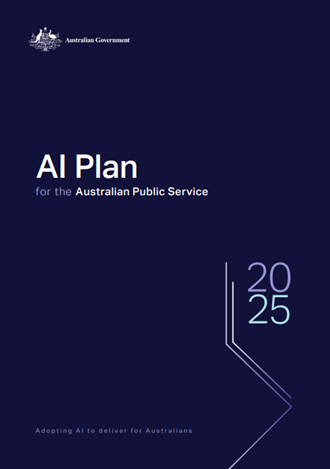
Capturing the opportunity of AI is vital to enhancing the Government’s ability to build world class data and digital capabilities, improve productivity and economic resilience, and deliver better policy and services for all people in Australia.
Harnessing the opportunity of AI and sharing its benefits is expected to help the APS improve standards of living in Australia. Realising the benefits of AI in Government requires a culture of innovation, accelerating the safe and responsible use of AI across all government agencies while maintaining the trust and confidence of the public.
Accelerating AI adoption
Over the next year, the Government will continue ensuring the Australian Public Service can lead an AI-enabled future.
The AI Plan for the Australian Public Service(Opens in a new tab/window) (the AI Plan) outlines a path to accelerate adoption of AI across the service, from policy areas to service delivery. The AI Plan identifies initiatives to support adoption and use of AI, structured around three pillars:

The AI Plan positions the Government to improve service delivery, efficiency and productivity by substantially increasing the safe and responsible use of AI in government.
As AI becomes increasingly widespread, the Government will continue to leverage this technology to achieve benefits for people and business, ensuring the right governance is in place and supporting people to use it safely.
Agencies will be supported to unlock the full potential of AI by leveraging cloud infrastructure, enabling real-time data access and supporting advanced analytics. The Government has developed a new whole-of-government Cloud policy to set clear requirements for cloud use, guiding agencies to accelerate uptake while maintaining compliance with protective security standards and uplifting workforce capability. It also enables efforts to address legacy migration challenges so that transitions are managed safely and efficiently.

of Australian Public Service staff were in data and digital roles in 2025.
Source: 2025 APS Census

Adopting AI responsibly
By establishing clear rules and guidance to support AI adoption in the Australian Public Service, the Government has made substantial progress in responsibly adopting AI. Getting the balance right will unlock the benefits of AI while minimising the potential for harm and privacy risks, including where AI may replicate existing biases and inequalities.
Government agencies are increasingly adopting AI, with over 70% identifying specific opportunities where AI can deliver measurable benefits to their work. AI Transparency Statements are making this AI use visible, understandable and comparable across government, with 81% of agencies reporting having measures in place to monitor the effectiveness of AI systems.
The Policy for the responsible use of AI in government(Opens in a new tab/window) provides the foundation for AI transformation in the Australian Public Service. Released in September 2024, it requires agencies to use AI ethically, transparently, and with clear lines of accountability. It mandates the appointment of AI Accountable Officials and the publication of AI Transparency Statements.
Since its release, the Government has updated the Policy for the responsible use of AI in government to include a broader set of AI governance practices that will support agencies to confidently adopt AI while building public trust.
This includes requiring agencies to develop a strategic position on AI adoption and to communicate this position to staff, to support agencies to better engage with and realise the benefits of AI. Accountability requirements will be strengthened so that each in-scope use case has a clearly assigned accountable officer and are recorded in an internal register.
The Policy for the responsible use of AI in government builds trust in government’s use of AI, including through mandating use of the AI Impact Assessment Tool, a practical assessment tool for evaluating risks and impacts of AI use cases against Australia’s AI Ethics Principles(Opens in a new tab/window). The tool supports agencies to identify and manage AI risks, leading to safer, more transparent, and accountable AI deployments to protect the public interest.
The Government’s new AI technical standard(Opens in a new tab/window) provides practical guidance for building, purchasing, and experimenting with AI systems. It is designed for technical specialists and business owners embedding AI in government systems, enabling agencies to confidently experiment with and develop AI use cases while maintaining alignment with public expectations and ethical principles. The standard outlines best practices for design, development, deployment, and use of AI systems, reinforcing Government’s commitment to AI Ethics Principles, and offers structured advice at every stage of the AI system lifecycle.
It was developed in collaboration with a cross-government working group, with an inclusive approach reflecting diverse perspectives grounded across various government contexts. The standard supports agencies to responsibly innovate and adopt AI, embedding accountability, safety and transparency and a future-ready approach to public sector AI implementation.
The Government is developing guidance to support agencies procuring AI products and services. It will continue to monitor and update its procurement panels to ensure agencies have access to trusted AI vendors, making it easier to source AI solutions that align with government standards.
Partnering to drive AI adoption

The Government has begun unlocking the benefits of AI by connecting industry, academia and government, helping businesses adopt AI effectively and safely.
In July 2025, over 650 industry representatives and APS staff attended the AI Government Showcase(Opens in a new tab/window), presenting unique use cases from government agencies and enabling small to medium enterprise AI vendors to connect directly with attendees.
The Government’s National AI Centre(Opens in a new tab/window) is supporting Australian industry to build confidence, capability and clarity in AI adoption to secure productivity benefits. This includes delivering best-practice guidance and building AI literacy.
In 2024 the Government established four AI Adopt Centres(Opens in a new tab/window) as part of the AI Adopt Program. The AI Adopt Centres support small and medium sized enterprises to adopt responsible AI-enabled services and enhance their business, leading to improved productivity and economic outcomes for Australia.
The Voluntary AI Safety Standard(Opens in a new tab/window), released in late 2024, provides business with practical guidance on the safe adoption of AI for innovative purposes Australian businesses have used the Voluntary AI Safety Standard to harness a range of AI opportunities, from warehouse accident detection to providing best value hotel accommodation for people, and reducing customer wait times using GenAI chatbots.
In late 2025 the Government will release a new suite of industry guidance building on the Voluntary AI Safety Standard, including extending best practices to developers, and the delivery of resources and tools to support responsible AI adoption.
Adopting AI to improve productivity
The Government is committed to developing AI solutions that increase productivity, solve difficult problems and provide simple and seamless services to people and business.
Agencies are already applying AI in diverse and impactful ways:
Services Australia
The Australian Taxation Office
The Department of Veterans’ Affairs
The Department of Employment and Workplace Relations’
The Department of Education and the Department of Employment and Workplace Relations
The National Library of Australia
Spotlight: Using AI to care for Country
The Tiwi Islands Ranger Ghost Nets program(Opens in a new tab/window) showcases community-driven environmental care, where local rangers harness AI-powered tools and drone technology to monitor and safeguard ecosystems.
The program detects and manages marine debris, particularly abandoned fishing nets and plastics, that accumulates along the remote northern Australian coastline and threatens the environment and wildlife.
A labelling platform, co-designed with rangers, enables annotation of drone imagery of marine debris which is then used to train AI models to recognise marine debris, ensuring that technology development is grounded in local knowledge and expertise.
This initiative demonstrates how AI is making a tangible difference in remote communities, enhancing environmental stewardship and delivering real benefits for both Country and community.

Enhancing AI capability in the public sector workforce
The uplift of digital skills and leadership across the public sector is central to AI adoption.
Implementation of the APS Data, Digital and Cyber Workforce Plan 2025-2030 (the Workforce Plan) will ensure the public service workforce is appropriately skilled and ready to lead government AI innovation. Released on 7 March 2025, the Workforce Plan provides a strategic framework to attract, develop and retain critical data, digital and cyber talent across the APS. This supports agencies to build and strengthen this critical workforce to deliver better policy, services and outcomes in a rapidly evolving digital landscape.
Spotlight: Enhancing workforce capability
The GovAI (Opens in a new tab/window)service provides Australian Public Service staff with practical, hands-on opportunities to build AI capability. Through the Interactive Learning Environment and Knowledge Hub, GovAI allows staff to safely explore AI tools, deepen their understanding, and apply their learning to real public service scenarios.
The Department of Finance created GovAI to allow APS staff to experiment safely with AI tools to improve public service delivery.
GovAI is a first of its kind platform exposing staff to technical services, resources and tools in a controlled environment. Staff will gain AI skills that are directly transferrable to real world scenarios, equipping them to use AI to connect and secure services to bring value to people and business.
